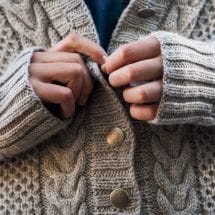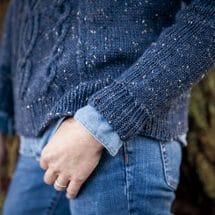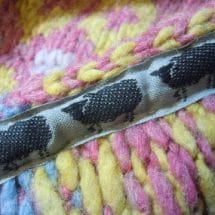 |
by Knit Picks Podcast on January 10, 2020
In the spirit of a new year full of crafting goals and bursting project queues, we’re taking a moment to think about the act of FINISHING knits. More than just weaving in ends, using the right finishing techniques for each project means you’ll have garments and accessories that will be treasured and look good for years to come. First up, Erica and Hannah talk about the importance of taking your time. Each finishing step, from picking the perfect buttons to using the right techniques along the way, add up to a subtle but important difference in the finished project. Next, Lee and Stacey cover the mysteries and intricacies of blocking. Truly one the last steps in the process, blocking can be much more than a ... |
Category Archives: Finishing Techniques
 |
by Hannah on January 24, 2017
Let's talk sweater care. You've spent what feels like an eternity knitting away at this single garment and now that it's off the needles it's time to start taking care of it in a way that will ensure that it's still around decades later (as every good masterpiece should). We've got a range of simple tools that will keep your knits in tip-top condition, ready to pop on for everything from yard work to snuggling in front of a cozy fire with a good book. |
 |
by Hannah on March 3, 2014
Spring looks like it's here, but the weather still isn't convinced. T-shirts are still relegated to storage and my sweater collection is in full rotation, I've even been double layering sweaters outside to do yard work. Cold days also means a cold house where hand washed things take a whole week to air dry (if I'm lucky) so I found myself contemplating a range of cheap polar fleece jackets to wear while I dig up bushes and mix compost into my soon-to-be dye garden in the back yard. I didn't see anything I liked, but I did see a bag of Brava Worsted in Peacock that looked pretty enticing so I gave in to my knitting needles and decided to cast on the Worsted Crewneck from Worsted Basics pattern collection. |
 |
by Hannah on February 10, 2014
Portland has been struck with a big, chilly ice stick this weekend. We've all been shut up at home, waiting out the weather (thankfully the power stayed on the whole time) and I bet more than a few of us were working on our craft projects! I spent the weekend feverishly finishing up a pretty basic pullover in Brava Worsted Peacock. You know the kind I'm talking about - acres of stockinette stitches, a good bit of positive ease for a comfy, simple layer. However, there was one part that I wasn't looking forward to wrestling with: set in sleeves. |
 |
by Knit Picks Staff on October 26, 2013
I'm a huge fan of details, especially when it comes to finishing projects. I like good, proper hems, perfectly coordinated buttons, and fine stitching along a steek. Even more than that, though, I love authentic touches. That's why I'm so thrilled that we're carrying authentic Norwegian pewter buttons and clasps and Swedish cotton ribbons from Lilleknappen! I've been waiting for this day for quite some time, actually. I found Lilleknappen when I was looking for good quality pewter clasps several years ago, and we've finally been able to add their fantastic products to our lineup. That means that the pile of sweaters that have been waiting for trimming can finally be finished! (for two years my favorite Icelandic sweater has been held shut with a safety pin!) |
|
by Jenny K on May 14, 2013
A hemmed edge is one of the more subtle finishing details that can really add a polished look to your sweater or cardigan. Whether you add a hemmed edge to your cuffs, collar, or along the lower edges of your pullover – there are several advantages to using this simple, yet effective technique that leaves a very neat and clean edge. If you don’t want your fabric to pull in as a ribbed hem would and you want to avoid the bulk of a rolled edge – a hemmed edge just might be the perfect solution! Not only does a hem prevent your edges from curling, it also adds stability and keeps edges like cuffs and colors from stretching out over time. It is also a simple and classic design detail that won’t distract or compete with any other patterning that you might have worked into your pullover, making this a versatile skill to have in your mental library of knitting techniques. |
|
by Jenny K on April 12, 2013
Last week was the start of our sweater finishing video series where Kerin showed you how to set in the sleeves of a sweater. This week's segment entails a comprehensive look into the elusive collar! The first step to the collar will usually be picking up your stitches, which can be a bit tricky since you'll be working along straight and curved edges of the collar. Unsure of how to work a hemmed collar? Kerin covers that too! Check out Part 2 of our sweater finishing tutorial to learn how to pick up and knit a collar as well as how to sew down a hemmed collar. |
|
by Jenny K on April 4, 2013
Although binding off that last stitch on your sweater is extremely satisfying, there is usually a bit more work left to do in order for that sweater to be truly finished. Whipstitching a hem, grafting at the underarms, and picking up stitches for a buttonband or collar – these are the smaller details that require time and attention but may not be the most familiar of knitting techniques. So what’s a knitter with finishing woes to do? Why ask Kerin, of course! In addition to designing patterns for our kits and collections, Kerin is also well versed in a huge range of interesting and unusual knitting techniques. So it only seemed fitting that as she was casting off a cardigan and planning out the finishing details to put everything together into a video tutorial series on sweater finishing. The first part of this series focuses on how to set in the sleeves ... |
|
by Jenny K on September 11, 2012
After investing a great deal of time into knitting a sweater, you want to give it a beautiful finish. This often involves blocking the sweater to the proper dimensions. When you block a sweater, you are setting the stitches and evening out the fabric in addition to preserving the correct sizing. Generally, sweaters can be wet blocked (good for cotton and linen), spray blocked (good for wool and alpaca) or steam blocked (good for wool and alpaca) depending on their fiber content. And to make sure that your first sweater blocking session is a success, we have a handy video tutorial that walks you through all of the steps! The video also shows you what to do for the three different blocking methods (wet, spray and steam). That way you can match a blocking technique that is best suited for the fiber type of your sweater. |
|
by Jenny K on August 1, 2012
Weaving in your ends is one of the last steps in finishing pretty much any project, and is almost impossible to avoid one way or another. Now, how you weave in yarn ends - that is a whole other story! There are so many different ways to weave in ends. Some knitters save all of the ends for last, some weave them in every few inches as they go along their projects. And sometimes, it also just plain depends on what kind of yarn you are using! And in this case, we have a handy video tutorial that shows you just how to make sure those ends stay woven in when you are working with smooth yarns and plant-based fibers like cotton and linen blends. So grab your tapestry needles and get ready to finish all those projects that have a few (or many!) leftover ends still hanging out. |

